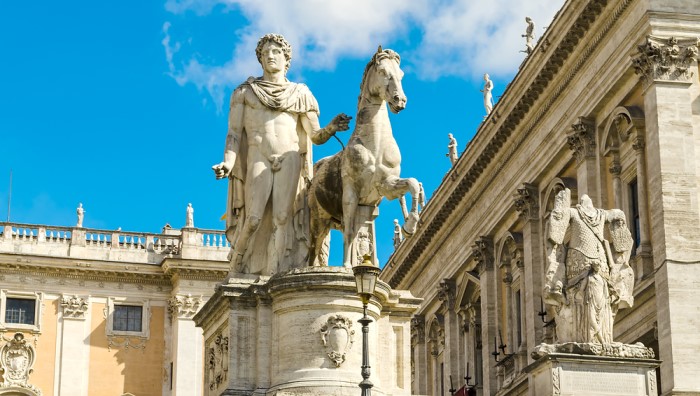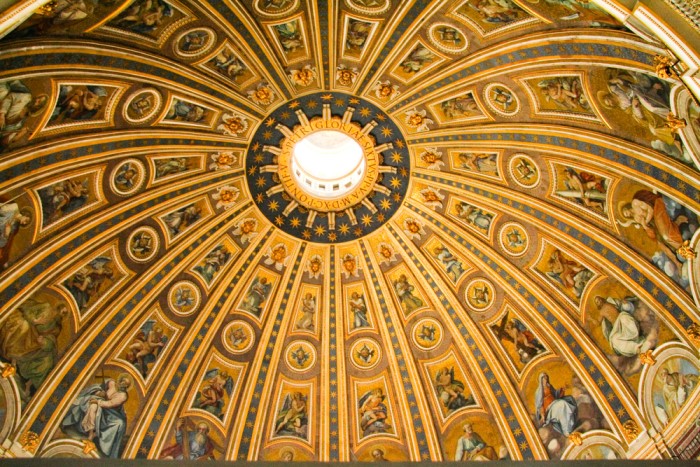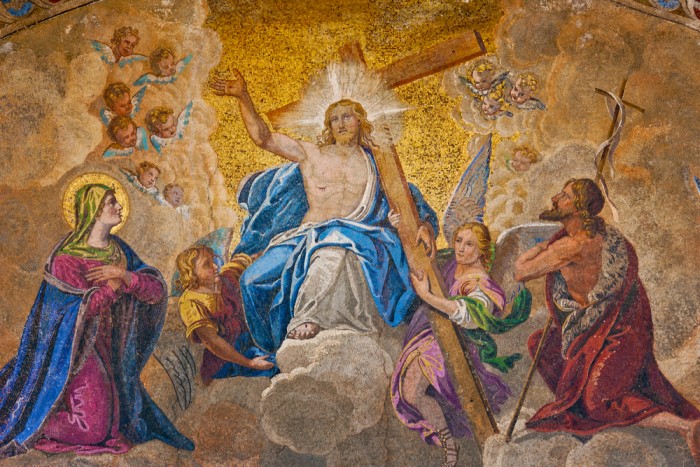
"When Michelangelo was introduced to Titian, he said... that Titian's colouring and his style much pleased him, but that it was a pity that in Venice men did not learn to draw well from the beginning and that those painters did not pursue a better method in their studies."
(from "The Lives of the Greatest Painters, Sculptors and Architects", Giorgio Vasari)

Piazza del Campidoglio
When Michelangelo Buonarotti was born in 1475, he was brought up in the country of Arezzo, which was renowned for its population of stonemasons and sculptors. He excitedly said to Giorgio Vasari, his Florentine biographer: "Giorgio, if I have any skill at all, it's due to all the time I spent in the wonderful air of your province of Arezzo. I was nursed with the image of a statuette and a hammer; they are the two tools I use to create my artwork."
Michelangelo, a Renaissance artist who ventured into architecture, painting and poetry, always viewed himself as a sculptor first and foremost. His hometown, Caprese, was controlled by Florence, so he always considered himself a son of Florence; he also returned there regularly, however, it was in Rome where his talent and genius flourished and left their mark in the world of art, which can still be seen today.
Michelangelo made his way to the awe-inspiring city of Rome in 1496. At age 25, he finished his Pietà sculpture which is now located in the church of San Pietro in the Vatican. Maria's face shows compassion for her son, and her clothing is intricately crafted. Jesus is displayed in a lifeless state, embraced by her arms. In 1972, a madman damaged it, so it was determined to build an armored glass barrier around it.
As you enter the church of San Pietro, you can't help but feel something excited in your chest. The size of the church is extraordinary: the area of the hall is approximately 15,000 square meters and it can hold up to sixty thousand people. Michelangelo designed the remarkable dome, standing at 132 and a half meters tall, held up by four imposing arches. However, its construction wasn't finished until after his death, with certain engineering alterations.

Church of San Pietro
When you ascend the 330 steps to the top of the church, you can witness the magnificent view of the dome and wings. At the base of the dome, there is an inscription in Latin, which is a common feature of Catholic churches and even in Israel. It reads: "You are Peter, and on this rock, I will build my church and, in your hand, I will give the keys to the kingdom of heaven." You'll have to crouch and squeeze through the tight passageway between the inner and outer dome, but once you reach the peak, the reward is spectacular - from the Vatican Gardens to St. Peter's Square and all of Rome. It's a thrilling experience!
Despite Michelangelo's idiosyncratic tendencies, the Pope of Rome, the Medici family, and many others made every effort to recruit him and allocate him with fresh artistic projects for 17 years while he labored on San Pietro. It is unknown if he ever had a chance to lead a personal life after all the jobs he was involved in.
In 1501, he returned to Florence for a fleeting moment but was able to create his masterpiece, the famous statue of David. When he was thirty, Pope Julius II beckoned him to Rome and gave him the grand task of sculpting a tomb for him. This huge endeavor, which was supposed to comprise forty sculptures, was to be the bane of Michelangelo for the next forty years - five contracts were signed, however, many of the sculptures never saw completion.
The result of Michelangelo's labor was quite remarkable and can be found in the church of San Pietro in Vincoli. There, in a monument of niches, the sculpture of Moses was placed, with Leah and Rachel as his backdrop. Michelangelo asserted that sculpting was the superior art form, that he was carving in stone to release the figure inside, and what a stunning figure it was! With his left leg drawn back, it appears as if Moses is about to stand. He holds the tablets of the covenant in his right hand and his beard in the other, his left arm outstretched and every muscle and tendon visible. It's truly a sight to behold!
Michelangelo's expertise in anatomy, which he acquired from late-night dissections of cadavers, is quite evident in many of his sculptures, including the one of Moshe. Contrary to popular belief, the horns protruding from his head are not a sign of Satan, but a misinterpretation of the Hebrew phrase "the horn of the skin of Moshe's face" (Exodus 34:35). As I gazed in admiration at this impressive piece of art, I was struck by Michelangelo's appreciation of Moses and the tremendous responsibility he bore.
From creation to Judgment Day
At the Vatican Museum, deep within a maze of paths and hallways, is the magnificent Sistine Chapel (Cappella Sistina), created by Pope Sixtus IV in the late 15th century. The grand chamber, with its forty-meter length, 21-meter width and 13-meter height, is usually filled with fascinated visitors gazing up at the gorgeous fresco painted by Michelangelo on the chapel's ceiling. It is impossible not to be captivated by this enormous work of art that adorns the hall where cardinals assemble to elect a pope. Michelangelo, who had only ever painted one fresco before, personally installed the lofty scaffolding and spent four years, starting in 1508, crafting one of the most remarkable murals in the world. Rather than reclining, he toiled in a strenuous standing position to complete his masterpiece.

The Last Judgement by Michelangelo, Sistine chapel
In the middle of the mural, the renowned depiction of Adam's creation can be seen, with the creation of Eve alongside it, as well as the original sin, the banishment from Eden, and the narrative of Noah's intoxication. Additionally, the chapel's edges showcase the Sibyls, those ancient prophetic females, and the prophets of Israel.
After two decades, Michelangelo completed the Doomsday painting and hung it on the altar wall. It depicted Jesus the Judge in the middle, with the virtuous ascending to the heavens on the right, and the wicked falling to hell on the left. Among the saints, Bartholomew was featured, with Michelangelo's self-portrait painted onto his skin.
The artist's work was commonly applauded, however, there was one rare exception.
In 1521, Michelangelo unveiled a sculpture that drew some interesting feedback: "Naked Christ Carrying the Cross" (di Cristo Resurrezione), which depicted Jesus' resurrection. It stands in the church of Santa Maria Supra Minerva (Santa Maria Sopra Minerva) close to the Pantheon.
Critics have argued that Jesus looks more like a young Greek deity than a resurrected Messiah. The artist Sebastiano del Fiombo even excitedly expressed his admiration, saying that Christ's knees are worth every palace in Rome combined!
From stacking buildings to a beautiful square
The iconic dome of San Pietro is just one of the many accomplishments of Michelangelo, who also designed the stunning Palazzo Farnese. Now housing the French embassy, this Renaissance masterpiece is lauded for its beautiful windows, each a different shape from floor to floor, and its ornate stone entrance gate. Piazza del Campidoglio (Capitol Square) is another of Michelangelo's architectural gems - before he was done with it, it was a chaotic landscape of mismatched palaces belonging to the curators and senators. But now, it's a work of art!

Moses, church of San Pietro
Michelangelo had the vision to construct a new palace in front of the Palazzo di Conservatory, to give the area the order it was missing and form an attractive group of structures. He crafted the extension with ornamental geometric shapes and also devised practical stairs for climbing. As a result, the area was changed from a disorganized collection of buildings into one of the most celebrated squares in Rome, and even in the world, which is truly exciting!
The senatorial palace is now the home of Rome's mayor, with the curators' palace and the new palace now showcasing the Capitoline museums. The best way to take in the square is to come after dark and witness the lights flick on. An artist has crafted the lighting to highlight the windows and cornices of the surrounding buildings, and the statue of Marcus Aurelius on his horse (the original is in the Capitoline Museum) is lit up beautifully against the backdrop of the clock tower at the square's end. It's a truly exciting sight to behold!
For quite some time, Michelangelo's talent was coveted by seven popes who sought to bolster their own reputations and the name of the Church. He was in high demand not just from these holy figures, but also from Francois, King of France, Charles V, Cosimo de' Medici, the Señoria of Venice, and even the majestic Sultan Suleiman.
Michelangelo succumbed to death in Rome at the ripe old age of 89 in 1564 but was laid to rest in his native Florence. He was buried in Santa Croce church, alongside the physicist and astronomer Galileo Galilei and the statesman and writer Niccolo Machiavelli. His biographer Giorgio Vasari designed a beautiful tomb for him, featuring three symbols of architecture, painting, and sculpture - the art forms which Michelangelo reinvented with his tremendous talent.